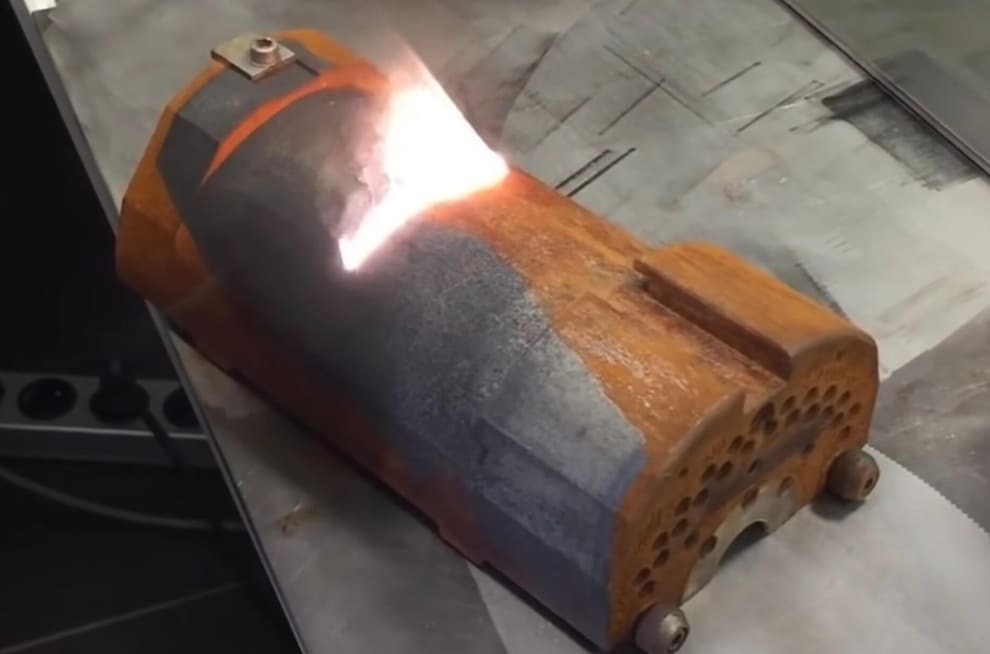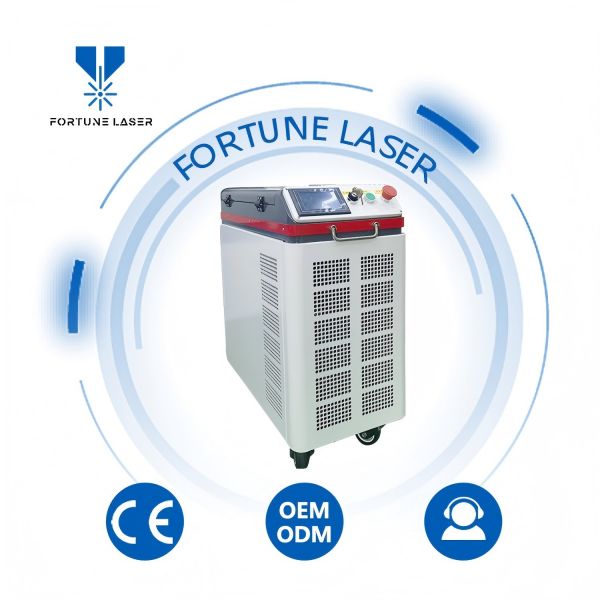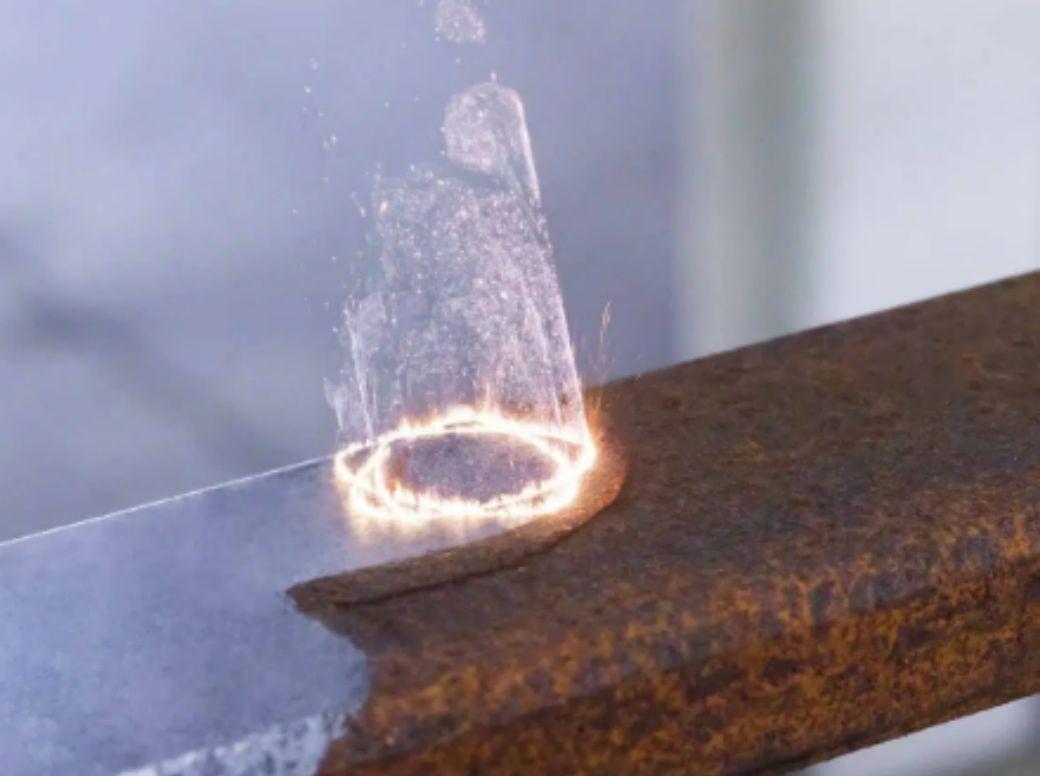Laser rust removal systems are a big step forward in cleaning and preparing surfaces. But they often cost a lot more than traditional rust removal methods. Many people wonder why these machines are so expensive. The high price is not random. It comes from a mix of advanced technology, top-quality parts, special manufacturing steps, market factors, and detailed operating needs. This article looks at the many reasons why laser rust removal systems carry a premium price.
The Science of Clean: Understanding Laser Ablation and Its Precision Advantage
The high cost of laser rust removal systems comes from the advanced science and precise engineering behind how they work. Unlike old methods that use force or chemicals, laser cleaning uses a careful process called laser ablation. This method has clear benefits that make it both effective and more expensive.
How Laser Ablation Works
Laser rust removal uses a strong, focused laser beam aimed at the rusty surface. The rust, paint, or other layers absorb the laser’s energy quickly. This sudden energy makes the material heat up very fast. The heat turns the rust and dirt into gas or plasma. This change from solid to gas is called laser ablation. The vaporized rust is then carried away or sucked out by a fume system. The laser’s settings—like wavelength, power, pulse time, and focus—are carefully adjusted. This ensures the energy hits mostly the rust, not the metal underneath. After the rust is removed, the clean metal shows with very little heat damage.
Inherent Advantages Driving Value
Laser ablation has many benefits that explain its worth. It is a dry process with no chemicals needed. This means no harmful solvents or waste to handle. The laser doesn’t touch or scrape the metal like sandblasting does, so the base metal stays safe. The laser beam can be aimed very precisely. It can clean small spots or tricky shapes without hurting nearby areas. Protecting the metal underneath is important, especially for delicate parts.
Advanced Process, Higher Cost
Because laser ablation is so advanced, the technology behind it is complex. This is why laser rust removal costs more than simple mechanical or chemical methods. Traditional ways use basic tools or chemicals in bulk. Laser cleaning needs special lasers, exact energy control, and smart systems to work properly. All these parts add up to a bigger upfront cost for the machine.
Core Component Breakdown: Why the Laser System Itself is a Major Investment
The main reason laser rust removal systems cost so much is because of the advanced and specialized parts inside. These systems are made up of high-tech components that are carefully designed and built to very strict standards.
The Laser Source: Heart of the Machine
The laser source is the most important and often the priciest part. Two main types are used for rust removal:
- Pulsed Lasers: These are favored for precise cleaning with minimal heat, achieving high peak power in short bursts. Their complex technology (e.g., Q-switched fiber lasers) makes pulsed laser sources much more expensive than Continuous Wave (CW) sources.
- Continuous Wave (CW) Lasers: These emit a constant beam and are generally simpler and less costly per watt of average power. However, they typically require significantly higher power levels for rust removal.
Making good fiber lasers, whether pulsed or CW, takes complex steps in cleanroom factories. This includes making special optical fibers with rare-earth elements and carefully putting together laser diodes. The laser must create a beam with exact features to clean rust well. This requires top materials and strict quality checks.
Power Levels (Wattage): Impact on Capability and Cost
Laser rust removal machines come with different power levels. For the same type of laser (pulsed or CW), higher power means the laser source and parts cost more. Higher power needs stronger laser diodes and better cooling systems. While more power cleans faster, it also makes the machine more expensive. Effective pulsed systems for rust removal often start around 50W, while CW systems typically need to start around 1000W to 1500W to achieve comparable cleaning effectiveness for many rust types.
Optics and Beam Delivery Systems
After the laser beam is made, it needs to be shaped, focused, and sent to the right spot. This job is done by the optics and beam delivery system, which uses costly, precise parts. Lenses and mirrors are made from special materials with coatings that can handle strong laser energy. Scanner heads use fast-moving mirrors called galvos to direct the beam quickly. Fiber optic cables, protected by armor, carry the beam from the laser source to the cleaning head.
Essential Supporting Systems
Other important systems help the laser work well and stay safe. These add to the total cost too. Cooling systems, often using water chillers, keep the laser and optics at the right temperature. Control systems with hardware and software manage the laser’s power, pulse speed (for pulsed lasers), and safety features. Special power supplies give steady energy to the laser diodes and electronics. All these parts are complex and add up to a big investment.
Beyond the Laser: Ancillary Equipment, Setup, and Operational Overheads
The laser system makes up most of the initial cost, but buyers need to think about other important parts and expenses too. These extra items are needed for safe and effective use.
Initial Setup, Integration, and Automation
Setting up the system can cost more. You might need professionals to install and calibrate the machine properly. For factories, the laser rust remover may need to fit into existing production lines. This can require custom parts or ways to move materials. Using a robotic arm to move the laser head can speed up work but adds a big cost. This includes the robot itself, programming, and safety barriers.
Fume Extraction and Filtration
Fume extraction is very important. Laser cleaning creates tiny particles and fumes in the air. A strong fume extractor removes these harmful particles to keep workers safe and the area clean. Industrial fume extractors with several filters add to the overall cost.
Specialized Training Requirements
Training for operators and maintenance staff is also needed. They must learn how to use the machine correctly, adjust settings, clean it, and follow safety rules. This training costs money but is important to keep the system working well and safely.
Initial Spare Parts and Limited Consumables
Initial spare parts and consumables, though fewer than traditional methods, should be considered. Protective lenses or windows in the laser head can degrade over time. Filters in the fume extraction system need periodic replacement. Coolant in chillers may also need periodic changing. These ancillary requirements contribute to the total cost of ownership.
Market Dynamics & Manufacturing Realities: The Economics of a Specialized Technology
The high price of laser rust removal systems is also affected by market and manufacturing factors. These make them different from common industrial tools that are made in large numbers.
Niche Market vs. Mass Production Impact
How many units are made plays a big role in cost. Laser rust removal is a niche technology, not as common as angle grinders or sandblasters. Those traditional tools are made in large amounts. This lets manufacturers lower the cost for each unit. Laser rust removal machines are made in smaller numbers, so each one costs more to produce.
Research & Development Investment
Laser technology keeps improving. Making better, stronger, and easier-to-use laser systems needs a lot of money spent on research and development (R&D). Companies include these R&D costs in the price of the machines.
Specialized Components and Supply Chain Factors
The parts used in laser rust removal systems are very specialized. They often come from just a few suppliers around the world. Parts like special optical fibers, coated lenses, and laser diodes are made by only a few companies. This means the parts can be more expensive. Strict quality checks on these important parts also add to the cost. The price shows that these are advanced tools made in a growing market with a complex supply chain.
Safety, Compliance, and Regulatory Hurdles: Adding to the Overall Cost
The power of laser rust removal systems means they must meet strict safety rules and standards. Making sure systems meet these rules costs money for manufacturers, which affects the final price.
Laser Safety Classifications and Engineered Safeguards
Most industrial laser rust removers are Class 4 lasers. This means they can be very harmful to eyes and skin if not used carefully and can even be a fire risk. Manufacturers must build in strong safety features. These include locks that shut off the laser if doors are opened, shields to block the laser beam, emergency stop buttons, and warning lights. Designing and adding these safety parts costs money.
Personal Protective Equipment (PPE) Considerations
Even with machine safeguards, operators need Personal Protective Equipment (PPE). Manufacturers must tell users what kind of laser safety glasses or face shields to use. These special glasses protect eyes from stray laser light and are not cheap. Good instruction manuals and safety training also add to the cost.
Industry Standards and Certification Expenses
Selling industrial machines, especially lasers, means following many national and international rules. For example, machines sold in Europe often need a CE mark to show they meet safety and environmental rules. In the U.S., the FDA has rules for lasers. Getting these certifications means lots of testing, paperwork, and checks, which are expensive for companies. These necessary costs are part of the machine’s price.
The Price Spectrum: How Features and Capabilities Define Cost Tiers
Laser rust removal systems exhibit a wide price spectrum, defined by features, power levels, and automation.
Handheld vs. Automated Systems
Handheld laser rust removers are typically the most accessible in price. Operators manually direct a lightweight processing head. Their overall system complexity is lower than automated solutions. Automated or robotic laser rust removal systems integrate the laser head with CNC gantries or robotic arms. This allows programmable, repeatable cleaning for high-volume tasks. The integration of robotics, advanced motion control, and safety enclosures adds substantial cost.
Impact of Laser Type, Power, Features, and Build Quality
Within both categories, the type of laser and its power significantly influence price.
- Laser Type & Starting Power: As mentioned, pulsed lasers are much more expensive than CW lasers. A lower-power pulsed system (starting around 50W for many rust applications and offering high precision) can cost more than a much higher-power CW system (often starting around 1000W-1500W for effective rust removal, which may be less precise regarding heat input). This creates different price points for different needs.
- Power Scaling: For both pulsed and CW lasers, as power increases, so does the cost of the laser source and supporting components.
- Other Features: Advanced feature sets, such as sophisticated software for parameter control, surface mapping, or data logging, also increase cost. Beam shaping options and specialized optics add further expense. The build quality, robustness, and brand reputation of key components also affect the price.
Why High-Specification Systems Cost More
A high-power, automated system for industrial use combines an expensive laser core (whether high-power pulsed or very high-power CW) with the costs of robotics, advanced controls, and safety infrastructure, leading to a much higher price than a basic handheld unit. Each added layer of capability builds upon the base cost.
Justifying the Investment: Long-Term Value, Efficiency, and Unique Benefits
Laser rust removal systems cost a lot at first. But over time, they can save money and offer unique benefits.
Reduced Long-Term Operational Costs
One big saving is on ongoing costs. Laser cleaning doesn’t need consumables like abrasives or chemicals. This means you don’t have to keep buying those supplies. Traditional methods create lots of waste that needs special, costly disposal. Laser ablation turns rust into vapor, and the fume system catches only a small amount of dry dust. This cuts down on expensive waste handling.
Minimized Material Damage and Asset Preservation
Laser cleaning doesn’t touch or wear down the base metal. It removes only rust or coatings while leaving the metal underneath safe. Grinding or blasting often damages the material. For valuable parts or old artifacts, avoiding damage is very important. This makes laser systems very useful.
Increased Efficiency, Speed, and Automation Advantages
Laser rust removal works fast and steady. It cleans surfaces quickly and with less setup and cleanup time. Robots can automate the process, allowing nonstop work. This cuts labor costs and keeps results consistent.
Environmental and Worker Safety Benefits
Laser cleaning is better for the environment. It doesn’t use harmful chemicals or create dusty waste. This also makes the workplace safer, which can lower health costs.
When Precision Outweighs Initial Price
For jobs needing careful, gentle cleaning or tricky shapes, laser rust removal may be the best or only option. Even if it costs more at first, it can save money in the long run. It’s important to look at the total cost over time before deciding.
Traditional vs. Laser: A Cost-Benefit Perspective
A direct comparison contextualizes why laser systems are considered expensive.
| Factor | Traditional Methods | Laser Rust Removal |
|---|---|---|
| Initial Investment Differences | Low initial equipment cost (e.g., sandblasting, grinding, chemical baths). | Significant upfront investment required. |
| Consumable Cost Comparison | Incur continuous consumable costs (e.g., abrasives, chemicals, discs). | Virtually no direct consumables during the cleaning process. |
| Labor Cost Implications | Can be labor-intensive; often requires significant setup, operation, and cleanup. | Can offer labor savings through increased speed, potential for automation, and reduced prep/cleanup. |
| Waste Disposal Considerations | High waste generation (e.g., spent abrasives, chemical sludge), often hazardous, leading to high disposal costs. | Produces minimal physical waste, drastically reducing disposal volume and costs. |
| Material Damage and Integrity Costs | Risk of damaging or altering the base material (e.g., abrasion, etching, embrittlement). | Offers precision cleaning, preserving material integrity and original dimensions. |
| Process Speed, Efficiency, and Quality | Speed and efficiency vary; quality can be inconsistent and operator-dependent. | Can be fast, offers consistent, repeatable, and high-quality surface cleaning results. |
| Environmental, Health, and Safety (EHS) Factors | Often involve EHS concerns (e.g., airborne dust, chemical exposure, noise pollution). | Offers an improved working environment; cleaner process with proper fume extraction. |
While traditional methods win on initial purchase price, laser rust removal often presents a stronger case when evaluating total cost of ownership and long-term benefits for specific applications.
Conclusion: Balancing Upfront Expense with Advanced Capabilities
Laser rust removal systems are expensive because of their advanced laser ablation technology. They use precise, specially made parts like laser sources and optics. These core components cost a lot. The machines also need extra equipment, careful setup, operator training, and strong fume extraction systems.
Market factors add to the price too. These systems are made in smaller numbers than traditional tools. Companies sped a lot on research and development. Strict safety features and rules also increase the cost.
Even with the high upfront price, the benefits are clear over time. You save money because there are no consumable materials to buy. There is less waste to dispose of, and the metal underneath stays safe. The process is faster and can be automated, saving labor costs. It is also safer and better for the environment.
For jobs that need great precision and gentle cleaning, laser rust removal is often the best choice. As more people use this technology and it improves, prices might go down. But because it is so advanced, it will likely stay a premium, valuable cleaning method.
FAQs
1. What is the main reason laser rust removal systems are expensive? The primary expense is the advanced laser source itself (especially pulsed lasers) and precision optics. These high-tech components require specialized manufacturing, high-quality materials, and significant research and development investment, making them inherently costly.
2. Are there ongoing costs with laser rust removal after buying the machine? Ongoing costs are significantly lower than traditional methods. Laser rust removal uses virtually no consumables like abrasives or chemicals. Main recurring costs involve electricity, periodic replacement of protective lenses or fume extractor filters, and minimal maintenance.
3. Can laser rust removal damage the metal underneath the rust? No, when operated correctly, laser rust removal is exceptionally gentle on the base material. The laser is precisely tuned to ablate (vaporize) the rust or coating without significantly heating or damaging the underlying metal surface, preserving its integrity.
4. Is a high-power laser always better for rust removal? Not necessarily. Higher power (wattage) can clean faster but increases system cost. For precision, pulsed lasers (often lower average power but high peak power) are preferred and can be more effective than higher-power continuous wave (CW) lasers for delicate tasks, despite sometimes being more expensive initially.
Post time: May-28-2025












